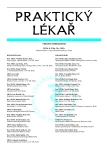Memory and its disturbances
Authors:
F. Koukolík
Authors‘ workplace:
Primář: MUDr. František Koukolík DrSc.
; Národní referenční laboratoř prionových chorob
; Fakultní Thomayerova nemocnice s poliklinikou, Praha
; Oddělení patologie a molekulární medicíny
Published in:
Prakt. Lék. 2008; 88(2): 82-87
Category:
Various Specialization
Overview
The memory in the human brain is not a unified system. Widely accepted classification discerns short-term working memory, long-term conscious declarative memory (semantic and episodic) and several types of non-conscious memories: procedural (habit), priming, pavlovian conditioning and emotional conditioning. The amnesia is a disturbance of declarative memory. The anatomic classification of amnesia differentiates the hippocampal, and diencephalic amnesias, amnesia in disturbance of the basal telencephalon and damage of some types of brain white matter systems. Minimal cognitive impairment and evolution of Alzhei-mer’s disease are most obvious causes of evolving recent episodic memory impairment amnesia encountering the family doctor.
Key words:
short-term (working) memory, declarative, semantic, episodic, amnesia.
Sources
1. Baddeley, A. The fractionation of working memory. Proc. Natl. Acad. Sci., 1996, 93, p. 13468-13472.
2. Cabeza, R., Rao, S.M., Wagner, A.D. et al. Can medial temporal lobe regions distinguish true form false? An event-related functionl MRI study of veridical and illusory recognition memory. Proc. Natl. Acad. Sci. USA 2001, 98, p. 4805-4810.
3. Cabeza, R., Prince, S., Daselaar, S. M. et al. Brain activity during episodic retrieval of autobiographical and laboratory events: an fMRI study using novel photo paradigm. J. Cognitive Neuroscience 2004, 16, p.1583-1594.
4. Gadian, D.G., Alcardi, J., Watkins, K.E. et al. Developmental amnesia associated with early hypoxic-ischaemic injury. Brain 2000, 123, p. 499-507.
5. Hort, J., Rusina, R. a kol. Paměť a její poruchy. Paměť z hlediska neurovědního a klinického. Praha: Maxdorf Jessenius, 2007. ISBN 978-80-7345-004-5.
6 Koukolík, F. Funkční systémy lidského mozku. Norma a poruchy. 3. přepracované a rozšířené vydání. Praha: Galén, 2008 (v tisku).
7. Lee H.Y., Kim, J.H., Weon, Y-Ch. et al. Diffusion-weighted imaging in transient global amnesia exposes the CA1 region of the hippocampus. Neuroradiology 2007, 49, p. 481-487.
8. Maguire, A. E., Frith, Ch.D. Lateral asymmetry in the hippocampal response to the remoteness of autobiographical memories. J .Neurosci. 2003, 23, p. 5302-5307.
9. Milner, B., Squire, L.R., Kandel, E.R. Cognitive neuroscience and the study of memory. Neuron, 1998, 20, p. 445-468.
10. Scoville, W.B., Milner, B. Loss of recent memory after bilateral hippocampal lesions. J. Neurol. Neurosurg. Psychiatry 1957, 20, p. 11–21.
11. Summerfield Ch., Greene, M., Wager, T. et al. Neocortical connectivity during episodic memory formation. PloS Biology 2006, vol.5. e128 DOI:10.1371/journal.pbio.0040128 (www.plos-bio-logy.org).
12 Willingham, D.B. Systems of memory in the human brain. Neuron 1997, 18, p. 5-8.
Labels
General practitioner for children and adolescents General practitioner for adultsArticle was published in
General Practitioner

2008 Issue 2
- Metamizole vs. Tramadol in Postoperative Analgesia
- Memantine in Dementia Therapy – Current Findings and Possible Future Applications
- Metamizole at a Glance and in Practice – Effective Non-Opioid Analgesic for All Ages
- What Effect Can Be Expected from Limosilactobacillus reuteri in Mucositis and Peri-Implantitis?
- Metamizole in perioperative treatment in children under 14 years – results of a questionnaire survey from practice
Most read in this issue
- Memory and its disturbances
- Current possibilities and problems of antiretroviral therapy
- The hoarding of possessions and animals
- Acute toxic hepatitis following consumption of a herbal preparation
